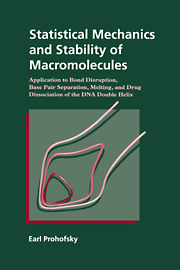 Statistical Mechanics and Stability of Macromolecules
Statistical Mechanics and Stability of Macromolecules Published online by Cambridge University Press: 16 September 2009
Dynamics of conformation change
Biological macromolecules often undergo changes in shape carrying out their biological function. For example the action of muscle fibers involves a relative rotation of a section of a macromolecule. An important change in shape in DNA is the B to A conformation change that is caused by changes in the level of hydration of the helix. The A conformation is the low hydration form. In that transition no valence bonds, and likely no H-bonds, are even transiently disrupted. The change is mostly to the helicity of the helix, going from a complete turn in 10 base pairs to one in 11 base pairs. In the process the width of the helix increases, the length decreases, and the base pairs tilt away from the perpendicular to the helix axis (Saenger, 1984). Analysis of this transition has been carried out in the context of a soft mode displacive change transition (Eyster and Prohofsky, 1977; Lindsay et al., 1985). Displacive change is useful for transitions that involve continuous movement of atoms from one conformation to another, i.e. where the transition is second order. The mode that goes soft, in soft mode analysis, is related to the softening of the free energy barrier that separates the free energy minima as a function of order parameter, as discussed in a previous chapter.
To save this book to your Kindle, first ensure [email protected] is added to your Approved Personal Document E-mail List under your Personal Document Settings on the Manage Your Content and Devices page of your Amazon account. Then enter the ‘name’ part of your Kindle email address below. Find out more about saving to your Kindle.
Note you can select to save to either the @free.kindle.com or @kindle.com variations. ‘@free.kindle.com’ emails are free but can only be saved to your device when it is connected to wi-fi. ‘@kindle.com’ emails can be delivered even when you are not connected to wi-fi, but note that service fees apply.
Find out more about the Kindle Personal Document Service.
To save content items to your account, please confirm that you agree to abide by our usage policies. If this is the first time you use this feature, you will be asked to authorise Cambridge Core to connect with your account. Find out more about saving content to Dropbox.
To save content items to your account, please confirm that you agree to abide by our usage policies. If this is the first time you use this feature, you will be asked to authorise Cambridge Core to connect with your account. Find out more about saving content to Google Drive.